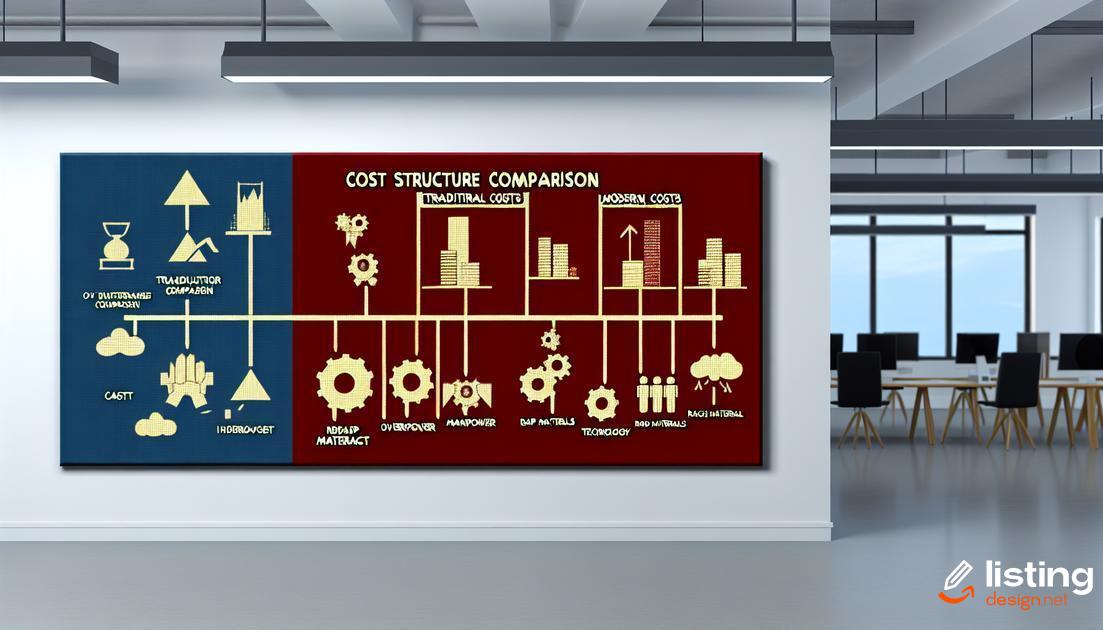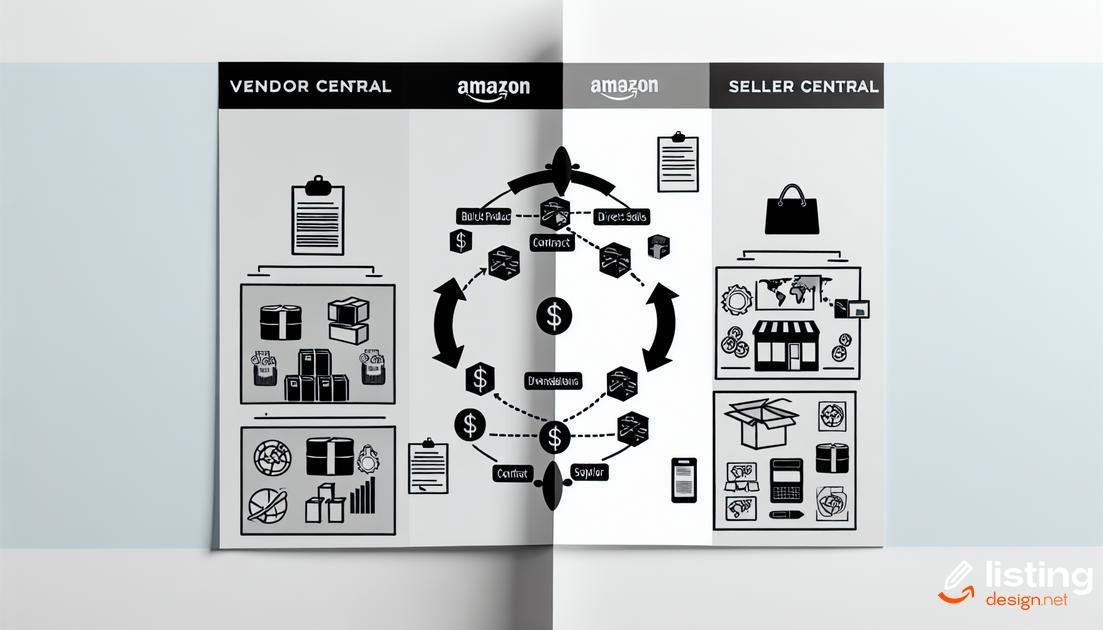Choosing between Amazon Vendor Central and Seller Central can be challenging for businesses looking to expand their reach on Amazon. Both platforms offer unique advantages, but understanding which one suits your business model can be critical. In this blog post, we’ll delve into the key differences, benefits, and drawbacks of each option. This guide will help you make an informed decision.
Table of Contents
Understanding Amazon Vendor Central
Amazon Vendor Central is designed for manufacturers and distributors who wish to sell their products wholesale to Amazon as a first-party supplier. Unlike Seller Central, where businesses sell directly to consumers, Vendor Central involves selling large quantities to Amazon, which then resells those products under the Amazon brand.
In Amazon Vendor Central, Amazon sends a purchase order to the vendor requesting a specific quantity of products. The vendor then ships these products to Amazon’s fulfillment centers. Amazon takes care of the rest, including listing the products, marketing, and handling customer service and returns.
One key feature of Vendor Central is the potential for higher visibility and sales volume. Products sold through Vendor Central are often eligible for placement in premium listings, such as the ‘Ships from and sold by Amazon.com’ tag, which can enhance consumer trust and improve conversion rates.
Vendor Central dashboard
The Vendor Central dashboard provides insights into sales performance, inventory levels, and forecasts. It also offers tools for managing purchase orders, invoicing, and promotions. However, it is less flexible compared to Seller Central, as Amazon has more control over product pricing and presentation.
Vendor Central users benefit from Amazon’s extensive logistics and customer service capabilities, allowing them to focus on production and supply chain management. On the downside, the relationship is more formalized, with stricter terms and conditions, including compliance requirements and chargebacks for non-compliance. Additionally, vendors may face longer payment cycles compared to Seller Central’s immediate access to funds.
Understanding Amazon Seller Central

Amazon Seller Central is a platform designed for third-party sellers to sell their products directly to Amazon customers. As a seller, you can list your products on Amazon and maintain control over your inventory, pricing, and branding.
Using Seller Central, you have the flexibility to manage your product listings, set your prices, and run your marketing campaigns. Seller Central also offers various tools and reports to help you optimize your sales performance and understand customer behavior.
Fulfillment by Amazon (FBA) is an option available to sellers using Amazon Seller Central. With FBA, you can send your inventory to Amazon’s fulfillment centers, and Amazon will handle storage, packing, shipping, and customer service for these products. This can be a great way to take advantage of Amazon’s extensive logistics network and provide fast, reliable shipping to your customers.
Sellers using Amazon Seller Central need to be aware of the fees, including referral fees, fulfillment fees, and subscription costs. It is important to calculate these costs to understand your profitability on the platform. Moreover, utilizing Amazon’s advertising solutions, such as sponsored products and Amazon PPC, can boost your product visibility and sales.
Key Differences Between Vendor and Seller Central
Amazon Vendor Central is an invite-only platform where manufacturers and distributors sell their products directly to Amazon. In contrast, Seller Central is open to any individual or business wishing to sell directly to customers on Amazon Marketplace.
One of the fundamental differences is the level of control and responsibility. Vendors in Vendor Central operate like suppliers. They sell their products in bulk to Amazon, which then takes care of pricing, marketing, shipping, and customer service. Sellers in Seller Central, however, maintain more control over pricing, listings, and inventory but also handle shipping and customer service, unless they use Fulfillment by Amazon (FBA).
On the pricing side, Vendor Central offers stability through negotiated costs with Amazon, whereas Seller Central sellers can adjust prices in real-time based on competition and market demand.
Branding and marketing also differ. Vendor Central provides access to premium advertising options, such as A+ Content and Vine, but with more restrictions. Seller Central offers a variety of marketing tools, such as Sponsored Products, but with a greater degree of flexibility and autonomy.
Another key point is the onboarding process. Vendor Central’s is stringent and by invitation only, implying a validation of your brand by Amazon. Seller Central, on the other hand, allows almost anyone to start selling, lowering the barrier to entry.
Lastly, customer service approaches differ. With Vendor Central, Amazon manages all customer service and returns, ensuring a consistent experience for the customer but limiting the vendor’s involvement. With Seller Central, sellers handle customer service unless they utilize FBA, which can affect the overall customer experience.
Pros and Cons of Amazon Vendor Central

Amazon Vendor Central offers distinct advantages for suppliers. One significant pro is the access to Amazon’s vast distribution network. Vendors sell in bulk to Amazon, who then handles the retail aspect, from pricing to customer service. This can lead to increased product exposure and potentially higher sales.
Another benefit is the ability to participate in Amazon’s marketing campaigns, such as Amazon Vine and Subscribe & Save. These programs can enhance product visibility and drive consumer trust.
However, there are cons to consider. Vendors have less control over pricing and branding. Amazon sets the retail price and can discount products without the vendor’s approval, impacting brand perception and profit margins.
Additionally, the onboarding process can be lengthy and selective, making it challenging for new suppliers to join. Smaller companies may also struggle with the bulk order requirements.
Understanding these pros and cons of Amazon Vendor Central can help businesses make informed decisions about their selling strategy on Amazon.
Pros and Cons of Amazon Seller Central
Pros of Amazon Seller Central
Greater Control: As a seller on Amazon Seller Central, you have full control over your product listings, pricing, and inventory. This allows you to make real-time adjustments to your selling strategy.
Branding Flexibility: You can create detailed product descriptions, add rich content like videos and images, and manage customer reviews directly. This enhances your brand’s visibility and reputation on the platform.
Access to Amazon’s Fulfillment: Leverage Amazon’s Fulfillment by Amazon (FBA) program to streamline shipping, returns, and customer service, thereby enhancing the customer experience.
Data Insights: Gain insights from Amazon’s reports on sales performance, customer behavior, and inventory levels, empowering you to make data-driven decisions.
Cons of Amazon Seller Central
Competition: Seller Central is open to all, which means you’ll be competing with countless other sellers, including Amazon itself.
Fees: While Seller Central provides numerous tools and services, these come at a cost. Referral fees, FBA fees, and storage fees can add up, affecting your profit margins.
Complexity: Managing your own listings, pricing, and inventory requires constant attention and can be time-consuming, especially for smaller businesses.
Customer Service Responsibility: Though Amazon offers support, you are ultimately responsible for addressing customer queries, issues, and returns, which can be demanding.
Cost Structure Comparison

When evaluating the cost structure of Amazon Vendor Central compared to Amazon Seller Central, it’s crucial to understand the different fees and financial responsibilities involved. Vendor Central operates on a purchase order model, where Amazon buys products at wholesale prices and resells them. This means that vendors need to account for lower margins, but they benefit from predictable purchase orders and payments.
On the other hand, Seller Central operates on a marketplace model, where sellers list their products directly on Amazon and are responsible for various fees. This includes referral fees, fulfillment fees, and possibly monthly subscription fees, depending on the plan chosen. While sellers might benefit from higher profit margins, they must manage inventory, shipping costs, and advertising expenses themselves.
Breakdown of Fees
Vendor Central: Vendors face costs mainly in terms of reduced margins due to wholesale pricing, but they aren’t burdened with referral or fulfillment fees. Amazon might also negotiate certain terms that can affect the overall cost structure.
Seller Central: Sellers are subject to several fees, such as:
- Referral Fees: A percentage based on the product category, typically ranging between 6-45%.
- Fulfillment Fees: Costs associated with storage, packaging, and shipping if using Amazon FBA (Fulfillment by Amazon).
- Subscription Fees: A monthly fee for professional selling accounts, providing more advanced tools and features.
Ultimately, the choice between Vendor Central and Seller Central will depend on your business goals, margins, and how much control you wish to maintain over your products and pricing strategies.
Control Over Pricing and Branding
Amazon Vendor Central offers limited control over pricing and branding as products are sold directly to Amazon, which sets the selling price. This can lead to unpredictable price drops affecting brand value. In contrast, Amazon Seller Central provides sellers with full control over pricing and branding. Sellers manage their listings, set their own prices, and have the flexibility to use custom branding elements on their storefronts.
Amazon Seller Central also allows sellers to run their own promotions and discounts, providing greater flexibility in marketing strategies. Brand Registry on Seller Central offers additional tools for brand protection, allowing sellers to quickly identify and report counterfeit products. This autonomy can benefit brands looking to maintain a consistent image and pricing strategy.
On the other hand, while Vendor Central’s reduced control might limit brand identity efforts, it often results in a higher volume of sales due to Amazon’s direct selling and trusted reputation. Opting for Vendor Central may suit businesses that prioritize volume over brand control.
Fulfillment Options and Shipping

Fulfillment Options and Shipping
When selling on Amazon, fulfillment and shipping play a crucial role in determining how your products reach customers. Vendor Central generally uses Amazon’s expansive distribution network to manage logistics. This means Amazon handles storage, packing, and shipping on behalf of the vendor. Seller Central offers two main fulfillment options: Fulfillment by Amazon (FBA) and Fulfillment by Merchant (FBM).
FBA allows sellers to store their products in Amazon’s warehouses. Amazon takes on the responsibility of picking, packing, and shipping the goods, as well as customer service and returns. This can significantly reduce the workload for sellers and improve delivery times. However, it comes with fees related to storage and fulfillment.
On the other hand, FBM lets sellers manage their own storage, packing, and shipping. This option offers more control over inventory but requires more effort and resources. Shipping speed and customer experience might vary depending on the seller’s capabilities.
Choosing between these options depends on your business needs and resources. While Vendor Central might offer streamlined logistics, Seller Central provides flexibility. Both have their own advantages, so it’s essential to assess which aligns better with your business strategy.
Marketing and Promotional Tools
Effective marketing and promotional tools are crucial for success on Amazon, whether you use Vendor Central or Seller Central. Each platform offers different opportunities to amplify your product visibility and drive sales.
With Vendor Central, Amazon takes on the marketing efforts for you. Their in-house marketing team might include your products in promotions, deals, and other marketing initiatives. This can be a powerful advantage, especially with access to the Amazon Vine program and A+ Content, enhancing your product listings with rich media, videos, and testimonials.
Amazon Vine Program
Amazon Vine allows trusted reviewers to receive products for free in exchange for unbiased reviews. This can significantly boost the credibility and visibility of your products by increasing the number of reviews from reputable customers.
In Seller Central, you wield more control over marketing but you’ll need to handle it yourself or hire external experts. Tools like Sponsored Products, Sponsored Brands, and Sponsored Display ads give you control over ad bids, targeting strategies, and budgets. These can increase visibility on search results and product detail pages.
Amazon A+ Content
Both platforms offer A+ Content, but Seller Central provides more customization options. Using high-quality images, detailed product descriptions, comparison charts, and unique brand stories, sellers can create engaging content that attracts customers and drives conversions.
Sponsored Ads
Sponsored Ads in Seller Central, including Sponsored Products, Sponsored Brands, and Sponsored Display, allow you to create paid campaigns targeting specific keywords or audience segments. This can drive targeted traffic to your listings, enhancing discoverability and sales.
Ultimately, the effectiveness of these tools depends on your marketing strategy and execution. Understanding the nuances and taking full advantage of the available tools on each platform can lead to increased sales and customer engagement for your business.
Customer Service and Returns Management

When it comes to Customer Service and Returns Management, the responsibilities and processes differ significantly between Amazon Vendor Central and Seller Central. In Vendor Central, Amazon handles all aspects of customer service and returns. This means that any questions, complaints, or return requests from customers are managed by Amazon’s customer service team. This can be a big advantage if you want to focus on production and logistics without dealing with individual customer issues. Additionally, returns are processed through Amazon’s return centers, which can streamline the process but also limit your direct control over return policies and customer interactions.
On the other hand, with Seller Central, you are responsible for all customer service and handling returns. This includes responding to customer inquiries, processing refunds, and managing any complaints or issues that arise. While this adds to your workload, it also gives you greater control over the customer experience and allows for more personalized service. If you value direct customer interaction and want to foster strong relationships with your buyers, Seller Central might be the better choice.
In both cases, a high level of customer service is crucial. For Vendor Central, ensuring that Amazon’s standards are met can indirectly reflect well on your brand. For Seller Central, providing excellent customer service can lead to increased customer loyalty and positive reviews, which can boost your sales and reputation on the platform.
Eligibility and Onboarding Process
To begin selling on Amazon, it’s crucial to understand the eligibility requirements and onboarding process for both Vendor Central and Seller Central. Each platform has distinct criteria and steps that need to be followed.
Vendor Central Eligibility
Vendor Central is an invite-only platform where Amazon reaches out to brands and manufacturers. Typically, only established brands and companies with a strong market presence receive invitations. This exclusivity ensures that products listed on Vendor Central are of high quality and have significant demand.
Seller Central Eligibility
In contrast, Seller Central is open to almost everyone, from small businesses to large enterprises. Anyone can create a Seller Central account and start listing products. This flexibility makes Seller Central a popular choice for startups and smaller businesses looking to enter the Amazon marketplace.
Onboarding Process for Vendor Central
Once invited, the onboarding process for Vendor Central includes several detailed steps. These involve signing an agreement with Amazon, setting up catalogs, providing product information, and establishing pricing. The process can be rigorous, but Amazon offers support to help vendors transition smoothly.
Onboarding Process for Seller Central
Registering on Seller Central is relatively straightforward. Sellers need to provide basic personal and business information, verify their identity, and set up bank details for payments. After registration, sellers can list products, set prices, and choose fulfillment methods. Amazon provides tools and resources to help sellers get started quickly.
Understanding these processes is crucial for determining which platform aligns best with your business goals. While Vendor Central offers direct selling to Amazon with a more controlled environment, Seller Central provides greater flexibility and autonomy for individual sellers.
Which is Better for Your Business?

When deciding between Amazon Vendor Central and Seller Central, it’s essential to analyze your business needs and goals. Each platform offers distinct advantages that can profoundly impact your online presence and operations.
Vendor Central allows businesses to sell products directly to Amazon. Amazon then takes responsibility for pricing, shipping, and customer service. This model is often preferable for brands that want to leverage Amazon’s vast infrastructure and marketing resources. However, it comes with less control over pricing and branding decisions since Amazon acts as the retailer.
On the other hand, Seller Central enables businesses to sell products directly to consumers on Amazon’s marketplace. This option offers greater control over pricing, branding, and fulfillment strategies. It requires more hands-on management but can result in higher profit margins and enhanced brand control.
Considerations:
- Volume and Scale: If your business is large and can benefit from bulk selling, Vendor Central may be suitable.
- Brand Control: For businesses prioritizing control over their customer experience and pricing, Seller Central is often better.
- Resource Allocation: Companies must evaluate if they have the resources to handle Seller Central’s operational demands or would benefit more from Vendor Central’s managed services.
The choice largely depends on whether your business values control and potential higher margins or prefers the convenience and scalability offered by Amazon’s direct involvement.


